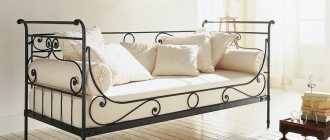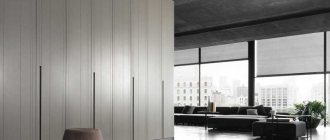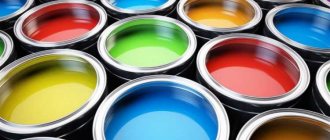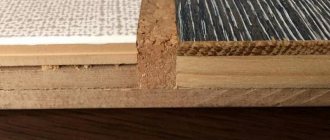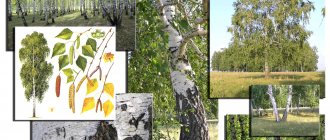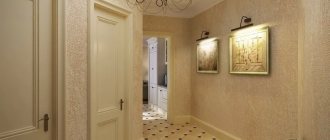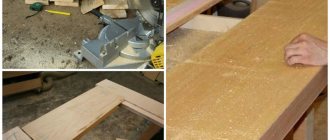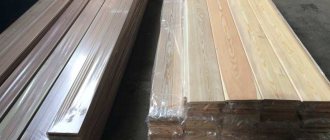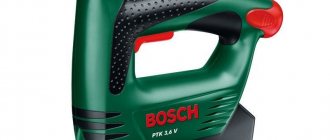Alkyd paint is very popular among consumers due to its affordable cost. The modern market offers a huge selection of different types of paints and varnishes of this group. Such paints stand out from other products due to the possibility of their application on a wide variety of surfaces.
Let's look at what alkyd paint is, what types of these paints and varnishes exist, how and for what they can be used, and find out the technical characteristics of paints and varnishes of the alkyd group.
Features of alkyd paint
Alkyd paint is quite versatile. The basis is an organic solvent, for example, purified kerosene. It also contains alkyd varnish, fillers in the form of sand, oil, and granite chips.
Production cannot be done without a solvent, which is often turpentine. Pigment provides a variety of colors.
Pay attention to what coating the paint is intended for. If it is wood, the composition must be supplemented with an antiseptic; an anti-corrosion component is required for metal coating.
PF-223
The paint and varnish material does an excellent job of creating a durable protective film on heating radiators. Resistance to high temperatures is one of the main properties of this product. The layer dries within 30-36 hours.
The paint is classified as very caustic, so manufacturers recommend using a respirator during work. The solvent for PF-223 is gasoline and solvent.
Advantages of alkyd paint
If you are still unsure whether to buy this type of paint, think about its advantages. Alkyd coating is durable, so you save on numerous alterations and repairs.
In addition to durability, you will immediately notice the elasticity of the paint. The surface will not become covered with cracks, and this paint does not shrink.
Whatever renovation you are planning, inside or outside the house, this material is ideal, which cannot be said about other options for paint and varnish products. you don’t have to be afraid of sudden changes in temperature - this coating can withstand from fifty degrees below zero to temperatures as high as fifty degrees!
- The surface coated with paint will be reliably protected. The benefits don't end there.
- Wide range of applications - metal, wood, concrete surfaces, as well as plasterboard, brick walls and many other materials.
- Strength and stability are ensured by a high level of adhesion.
- The material is also very convenient to work with - easy to apply, dries quickly, and economical.
You will also be pleased with the affordable price, especially considering the durability of the coating. The structure of the coating can be either matte or glossy. This also provides ample opportunities when creating a new interior design.
Comparison by main properties
Paint drying. The film obtained after applying alkyd enamel dries quite quickly than acrylic film. After just a few days, the alkyd film can properly perform its functions - both protective and decorative. For acrylic materials, the complete formation of the film takes a week or even more, and during this time the surface must be protected from mechanical stress.
Durability. The service life advantage is on the acrylic side. Intense exposure to the external environment means that alkyd surfaces have to be renewed after just a year. Moreover, if all preparation and application rules have been followed, the acrylic coating can last up to 8 years without the need for repainting.
Acrylic materials are more resistant to ultraviolet radiation. Unlike alkyd compounds, they do not fade and generally do not change the properties of the surface film.
Acrylic paints are also more resistant to mechanical stress, which in its way compensates for the longer preparation for the use of such coatings than for alkyd enamels.
While acrylic shows itself to be a more durable and stable material, alkyd-based compositions have a wider range of colors and shades, and after application the colors look much more vibrant.
Disadvantages of alkyd paint
Unfortunately, everything has its drawbacks. Alkyd paint was no exception. When working, you should be careful - the paint is highly toxic, has a strong odor, and may be harmful.
Low vapor permeability makes it necessary to be careful when using it in certain rooms. The material is also fire hazardous, as it contains flammable solvents. Despite its strength, the coating is quite unstable to alkali.
Application technology
Painting with alkyd paint is done as follows:
The surface is thoroughly cleaned of dirt and dust. Metal objects should be washed and dried. If there is old peeling paint on the product to be painted, it must be cleaned off with a spatula.
A layer of primer is applied to the surface. Of course, it is best in this case to also use an alkyd product.
The paint is evenly rubbed over the surface. It is best to use a roller to perform this operation. Alkyd paints have a fairly high viscosity, and therefore brush fibers can remain in the applied layer.
It is not recommended to apply alkyd enamels to hot surfaces (for example, functioning radiators). In this case, the paint will dry too quickly and may bubble. For better effect and longer service life, this type of paintwork should be applied in two layers. The waiting period between operations is usually 24 hours.
Types and composition of alkyd paint
When choosing paint, always pay attention to the composition. It is quite diverse and includes the following components:
- Alkyd resin. Very often you can find a varnish in the composition that binds the components.
- Solvents. The use of white spirit, or, in other words, kerosene, is quite common among manufacturers.
- Filler elements. This function is successfully accomplished by chips, such as granite or marble. Don't worry about the structure of the paint, the filler has a flour-like consistency and is evenly distributed.
The classification of alkyd paints includes two types. They are divided according to criteria such as the structure and composition of the paint:
- Oily. This composition is made using drying oil. They are not the most common, since a strong odor and fading in the sun are significant disadvantages. Products are purchased mainly due to low prices.
- Enamel. The use of alkyd varnish for the production allows enamel paints to be classified as a separate group. After hardening, a dense film is formed. Glyphthalic paint hardens fairly quickly and is best used for indoor renovations. The penphthalic mixture is universal and will also repel water perfectly.
Paints in the form of aerosols are very convenient to use - they are applied in a thin, even layer. You can often find components that are designed to impart certain properties. Such components are found in styrene, urethane paints and many others.
Marking
On cans of alkyd enamel the abbreviation PF or GF is indicated, which means that this alkyd paint is made on the basis of pentaphthalic or glyphthalic drying oil. When used in the production of melamine alkyds or alkyd-styrene mixtures, the ML or MS marking is used. Oil ones are marked with the letters MA.
The numbers following the letters indicate the properties of the composition and scope of application:
- 1 – is weather-resistant, allowed for outdoor use;
- 2 – cannot withstand temperature changes, can only be used indoors;
- 3 – a special type of paint intended for conservation (protection);
- 4 – increased moisture resistance;
- 5 – special properties, for example, luminescence or the ability to repel rodents;
- 6 – possibility of contact with petroleum products;
- 7 – resistance to acids and alkalis;
- 8 – increased heat resistance;
- 9 – high electrical insulating properties;
- 0 – primer mixtures.
The letters M (matte), PM (semi-matte) indicate the degree of gloss. The color of the paint is given without encryption, in ordinary words: white, gray, blue, etc.
Film former
An important component of enamel is the film-forming component. Such additives can be etrifthalic, pentaphthalic, xyphthalic.
Pigment
This is a special powder that makes alkyd paint opaque and acquires color. Can be either organic or inorganic. In addition to decorative, they perform a protective function.
Filler
Fillers are designed to make the paint more durable, viscous and opaque. The composition can contain silicates and carbonates. Organic fillers are also used as more dispersed ones.
Additives in the composition
Additives perform various functions, make the drying process faster, and increase the stability and plasticity of the composition. The stabilizer will evenly distribute the paint and prevent it from flaking.
Areas of use
Due to the fact that alkyd paints contain organic solvents, these paints are characterized by high adhesion to any surface - they can be applied to metal surfaces. The paints are suitable for painting wooden surfaces, as well as any other.
In this case, the coating not only has a protective function, but can also stop corrosion processes that have already begun. Therefore, the composition is applied to metal even with traces of rust. No preparation is needed - alkyd primer is applied to the surface without cleaning.
There are special alkyd coatings whose purpose is to work with metal. They are used for painting roofs, including galvanized metal, for application to metal fences, benches, pipelines, and heating radiators. Alkyd paints for metal contain corrosion inhibitors.
Alkyd paints for wood are used in finishing work on carpentry, in finishing work on log and cobblestone walls. These paints and varnishes are chosen for painting external structures and plank facades. Wood paint contains antiseptic components.
Along with special ones, there are also universal materials that can be applied not only to wood or metal, but also to cement surfaces, brick, and concrete.
On video: which is better – alkyd or acrylic paint?
Application of alkyd paint
You don't need any special skills; the paint is easy to apply. The preparatory stage is very important, when you clean and degrease the surface, remove the remnants of the previous coating.
- Prepare a solvent so that the paint is less viscous; if you choose aerosol paint, no solvent is needed, the composition is at the optimal consistency.
- Before work, stir the paint so that the consistency is uniform.
- Several coats of paint will look best and this finish will last. Tools for application - roller, brush, aerosol - you simply spray.
A wide range of alkyd paints allows you to choose exactly the one that is right for your renovation.
The main thing is to remember the safety rules when working with paint. When choosing a color, be guided by the color scheme of the main interior elements. Carefully read the composition of the paint, and then you will purchase high-quality products that will provide a durable coating.
PF-126
This type of enamels comes complete with a special composition (NF-1), the purpose of which is to speed up the drying process.
To obtain a high-quality result, use a roller or brush when applying. The work is carried out twice, creating thick layers. The drying time of the first is approximately 40 minutes. Thick paint can be thinned using white spirit.
Quick-drying, odorless paint for interior work - main types, selection tips and benefits of useThe best aerosol paint in cans - main types, application features and advantages of use
The best water-based paint - ranking of the best manufacturers of 2018
Photos of the best alkyd paint manufacturers
Aerosol products
Aerosol alkyd paint is available in special cans and is very convenient to use. It can be used to treat almost any surface and hard-to-reach areas, and the drying speed (about 5 hours) allows you to quickly start using painted elements.
- How to choose façade paint for exterior use - a review of popular manufacturers and a rating of the best paints for exterior use
- Which oil paint is better - a review of the best brands and criteria for selecting paints
The best interior paint for walls - 2022 rating and instructions for using interior paint
